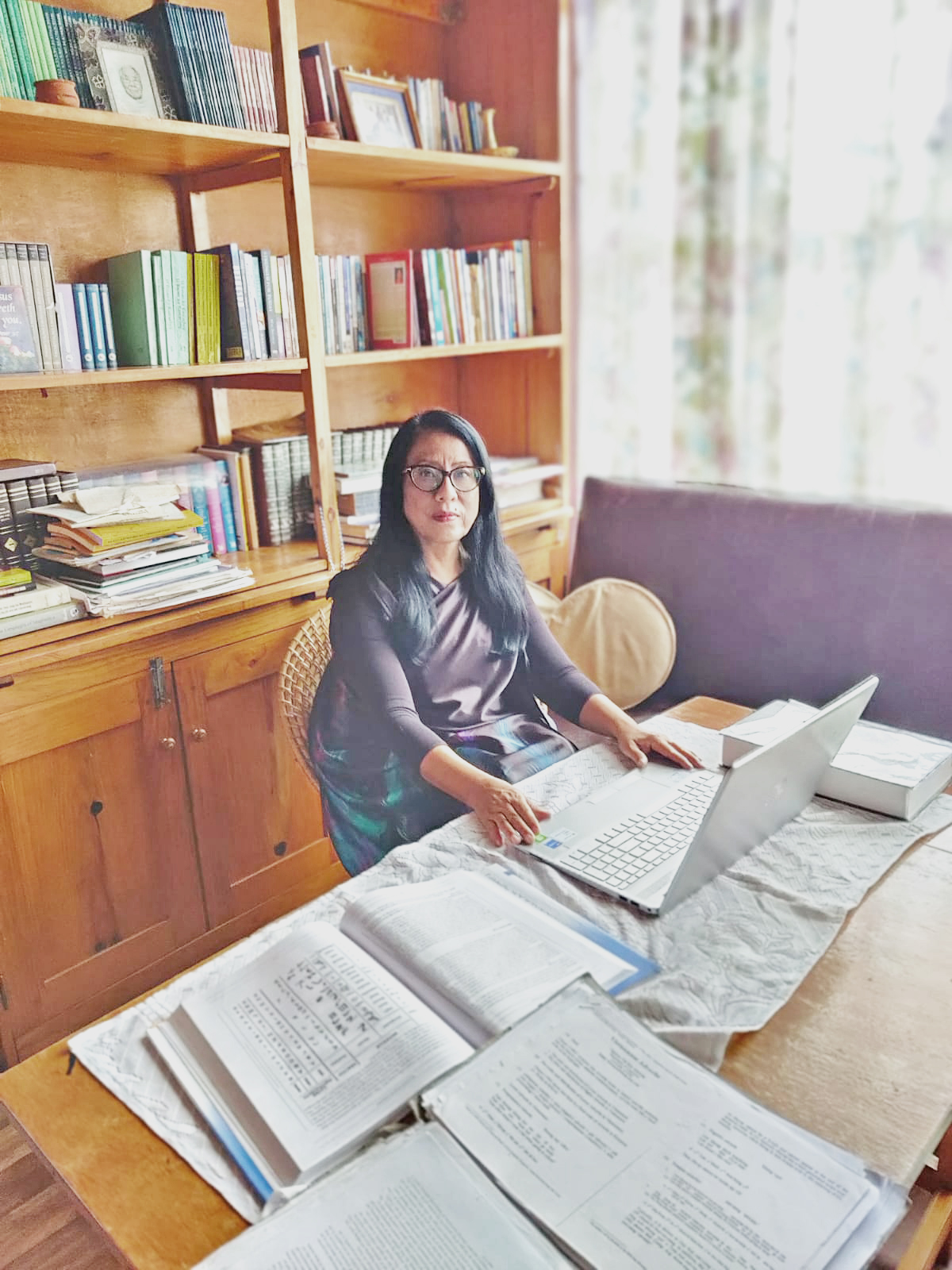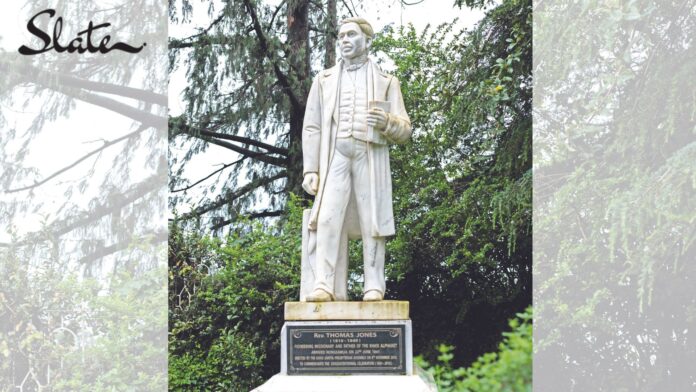By Babul Dkhar
Reverend Thomas Jones, a Welsh Christian missionary, who is also known as the father of the Khasi alphabet devised in the Roman script, has enabled thinkers and social leaders of the past to be able to document the oral traditions, rites, and rituals and the indigenous religion of the tribe.
According to Padma Shri Prof. Badaplin War of North-Eastern Hill University (NEHU), the Khasi script devised by Jones has made a tremendous impact and benefitted posterity all knowledge systems of the ancestors to be handed down from generation to generation.
“Thankfully it’s because of the script devised by Jones that we have what we have now. We know our roots, we know our traditions, we know our culture, otherwise, all this would have disappeared into oblivion,” War said.
She said that the script has empowered the tribe making them what they are today.
Out of all the dialects of the Khasis, Jones chose the one from Sohra since he landed there — then called Cherrapunjee — on June 22, 1841. Meghalaya observes June 22 as Thomas Jones Day, marking his arrival in Sohra.
While the Khasi language awaits recognition under the Eighth Schedule to the Constitution, there are certain criteria that a particular language has to fulfil before it could be considered a standard language.
War said that the first is a selection of one particular variety of dialect and in the case of Khasi it is the Sohra dialect.
She said that a language can be standardised using a natural process of selection or a planned process.
By way of example, War said that Hebrew in Israel was a planned process of selection whereby the country’s Parliament took the decision to make it once again the standard language of the country; even Indonesia has taken Bhasa as the standard language of the country.
In the case of Khasi, it is a natural selection because there was no conscious decision taken by any particular authority to make the Sohra dialect the standard variety of the Khasi language.
“It was a natural process because when Thomas Jones came to Khasi-Jaintia Hills Sohra was the place where he settled. So he took that particular variety of dialect for his convenience,” the Padma Shri awardee said.
The second stage is the codification process. The codification process deals with how one looks at the structure of a language and also at its acceptable forms, the vocabulary list or the dictionaries.
She said that the Khasi language was fortunate because the missionaries, right from the very beginning, had taken codification very seriously.
She said that in 1855, merely 13 years after Jones devised the Khasi script, William Pryse started the process of codification with the first grammar book.
Later on, more scholars and intellectuals came forward and contributed to the codification process and they included luminaries like U Nissor Sing, who codified the language with his first Khasi to English and English to Khasi dictionary.
War also informed that the codification process is an ongoing process and it is the same with the Khasi language.
“As a member of the Khasi Author’s Society, I am the supervisor of the project on the Khasi dictionary. There is a need now to have a much more standardised form of using the language,” she said even as she added that there is a need to keep on updating as in the case of many other languages of the world.
The third process is crucial for the standardisation of any language, which is an elaboration of functions.
When one talks of elaboration of functions there are many domains — education, judiciary, legislature, media, literary works and films.
Here one sees that the Khasi language has gone through a very long period of time.
When one looks at education it started right from the time of the missionaries in 1842 onwards when Jones started establishing schools in Shella, Mawsmai, Mawmluh and Sohra.
“The medium of instruction was Khasi. The language has had a chequered history in terms of education because as early as 1919 it was one of the subjects at Calcutta University. When Gauhati University was established, Khasi language was offered as a subject and with NEHU it has gone up to the level of PhD,” War said.

She informed that some scholars have worked on the standardisation process of the Khasi language using the criteria of socio-linguistic theories.
They have gone and collected data from the Khasi Hills Autonomous District Council where there are debates in the Khasi language.
The language is also used in the district courts, where cross-examination of witnesses is done in Khasi and even in the High Court translators are appointed.
Khasi is also used in debates and discussions in the Dorbar Shnongs, Raids and Himas.
In 2005 the state government made Khasi and Garo associate official languages and it is recognised by the government for use in administration up to the block and district level.
War said that as early as 1889 the first Khasi newspaper, “U Nongkit Khubor” (The news carrier), was published from Kolkata.
“The Khasi media also played an important role in the hill state movement for the creation of Meghalaya. In the field of media, Khasi language has developed substantially and research works are undertaken in the language in the field of folklore, culture, literature and linguistics,” she added.
War also said that acceptance of a particular variety of dialects is also very important.
“From the beginning for education as a medium of instruction, as a subject, as the lingua franca the Sohra variety has always been accepted by the speakers of the different varieties throughout the length and breadth of Khasi and Jaintia Hills,” she said.
She said that when one looks at these criteria, the Khasi language has actually passed through the different stages of standardisation according to socio-linguistic theories.
War also said that to enrich a language borrowing words from others or from own dialects are necessary.
According to her, English has borrowed extensively from other languages like French, Latin, Greek and also from Hindi besides some others.
“So borrowing should never be looked at as something detrimental to the development of a language. All languages of the world have to some extent borrowed from others due to language contact,” she said.
She also said that there is also internal borrowing and it has been there in the past and is still continuing.
Giving an example, she said that `Dheng kali’ (traffic jam) comes from the Bhoi dialect, `Dhareng’ which as per research means “cows stuck in a narrow path.”
Also, the word `Kalbut’ (stupid or silly person) comes from the Shella dialect and not the Sohra dialect.
She also said that another process of enriching a language is to coin new words.
“We are working on that, actually in our Khasi dictionary that is being developed, we are looking at how we can coin instead of borrow,” Prof. War said.
She also said that science and technology, media, films, songs and all kinds of activities around the world have an impact on a language.
“We have to see Khasi language is able to adapt to the changes that occur around us,” she said.
(The writer is a senior reporter with The Meghalayan)


